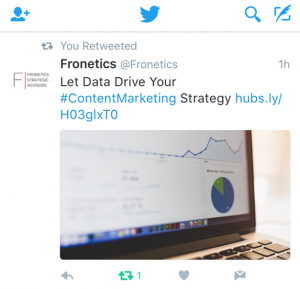
by Fronetics | Aug 2, 2016 | Blog, Content Marketing, Marketing, Strategy

Content marketing can help with lead generation and nurturing, but your business still needs a solid sales staff to close deals.
Content marketing helps generate a steady influx of quality leads and provides relevant information to prospects as they move down the sales funnel. Content can even help close a deal.
But forget any notion about content marketing replacing the work of your sales staff. The two must work together to convert leads into customers.
Even quality leads do not typically turn into sales on their own. You need a sales staff to take those opportunities and cultivate them into new business.
What content marketing does vs. your sales staff
Content marketing and sales staff provide different touch points for leads at distinct stages of the buying cycle. Here are a few examples:
Forming a relationship
- Content marketing opens up dialogue with potential customers. Often the first signs of customers’ interest appear after they read one of your blog posts, when they open and click through an email, or they share your company’s posts on social media channels.
- Your sales staff keeps that positive contact going to the next level. They develop it into a conversation. That person who read your blog post now has a relationship with a person in your company.
Providing information
- Content marketing can reach a potential customer early, while they are looking for solutions. B2B buyers report spending more time conducting research, using more expert content such as vendor websites, user reviews, and social media, before making a purchase. Your business should be producing content in order to make the short list of buyers who are looking for products and services like yours.
- Your sales staff answers those important first questions. When a customer reaches out with a query, s/he is likely 60% through the sales process. The customer has done a fair amount of research, and the sales rep must speak specifically to the customer’s needs — in a way that generic content can’t — to keep them interested and moving down the funnel.
Advocating for your brand
- Content marketing increases brand awareness for your business. It helps elevate your brand position within the industry and keeps your business top of mind, even when potential customers aren’t ready to make a purchase.
- Your sales staff is the advocate for your brand when a customer is preparing to make a purchase. They should be proactive in pursuing business when customers show interest in your content or when they reach out with questions. They drive dialogue and get to know customers and how your business can help them.
The content marketing, sales staff partnership
Curating and creating great content will generate quality leads for your company. But, your sales staff is vital to building relationships with potential customers and closing the sale.
Related posts:

by Fronetics | Jul 27, 2016 | Blog, Content Marketing, Marketing

Effective content marketers have these four things in common.
Think your content marketing could be better? You are not alone. Only 30% of content marketers feel they are effective, and, according to a recent survey, 55% of B2B marketers say they do not actually know what an effective or successful content marketing program looks like.
In fact, some of the key findings from the report, B2B Content Marketing 2016: Benchmarks, Budgets, and Trends – North America, may surprise you.
Recognizing success
First, the team must understand what they are striving for:
- Only 44% of B2B marketers say their organization is clear on what content marketing success or effectiveness looks like; 55% are uncertain. For success, everyone must understand what to look for.
- Only 32% of B2B marketers consider themselves sophisticated or mature in their skill-level. Sixty-four percent of those in the sophisticated/mature phase say they are effective at content marketing, while only 23% in the less-experienced adolescent phase express confidence. But, when strategies are documented, it appears to increase the confidence and success at every skill level.
What makes a team more effective at content marketing?
One key theme that emerged from the survey is that effective content marketers do these four things.
1) They know what effective content marketing looks like.
Effectiveness can be defined as meeting your overall goals and objectives — but in order to do so, those goals must be clear. B2B organizations that have a clear vision of content marketing success are more effective than those that do not. In fact, 79% of the most effective marketers report having that clarity, while 77% of the least effective say they lack it.
2) They have continuous communication.
The most effective B2B marketers (61%) meet daily or weekly with their content marketing team — either virtually or in person. Fifty-four percent say team meetings are valuable.
3) They document their content marketing strategy.
Documenting your content strategies can directly improve a marketer’s overall effectiveness. Fewer B2B marketers are doing this (32% in 2016 vs. 35% last year), even though research supports that a documented strategy can significantly improve results.
4) They document their editorial mission/long-term goals.
Research found that 48% of the most effective content marketers also have a documented editorial mission statement. This statement clearly defines who your audience is and why your content will be effective — it defines your brand. You should also document any long-term goals, like lead generation and sales, for example, will be the most important for most B2B content marketers over the next 12 months.
Having clear communication, documented goals, and defined strategies will provide direction, which can be the guiding light to effective content marketing. Implement these proven steps to better focus your team and to make effective content marketing clear and recognizable.
Related posts:

by Fronetics | Jul 26, 2016 | Blog, Content Marketing, Marketing, Social Media, Strategy

Your business should be on social media showing buyers that you know what they want and that your business can provide it.
Once again B2B buyers reported that their purchase cycle has increased since last year. That’s in part because they are scrutinizing potential vendors more closely than ever before. Buyers overwhelmingly reported spending more time conducting research (80%) and using more sources to investigate purchases (73%).
You may be surprised to learn that one of those sources is social media, more often than not. More than half (53%) of B2B buyers report turning to social media to make buying decisions. What’s more, more than a third (34%) say they are spending more time this year than last using social media to research vendors and solutions.
Social media should be a critical component of your lead generation and nurturing strategy. Your business should use these platforms to prove that you understand what buyers are expecting from your brand. The 2016 B2B Buyer’s Survey Report found that today’s B2B buyers expect:
- Timely responses to messaging: Demonstrating a timely response to questions helped make the sale 98% of the time.
- Strong knowledge of the company and its needs: Personalization ranked as the second most influential reason a buyer chooses a specific vendor. When researching potential products, 64% gravitated toward companies that demonstrated “a stronger knowledge of our company and its needs.” A whopping 84% chose a vendor that could solve one of their pain points.
- Clear demonstration of ROI: Buyers reported conducting a more detailed ROI analysis before making a purchase. Vendors who can demonstrate how customers will receive their return on investment have a clear advantage. In fact, 90% of businesses that do this make the sale, according to the study.
- Speedy and easy delivery: “Deployment time/ease of use” skyrocketed from 49% in 2015 to 83% this year, leading the ranks as one of the most important variables that can set you apart from your competition. Buyers not only want it quickly, but they want a simple and easy buying process.
Which social media platforms do B2B buyers use most in their research?
The B2B Buyer’s Survey found that buyers primarily are using three social tools to conduct their research.
- LinkedIn is reportedly the most impactful to the research process. (81% said it was very important or somewhat important.)
- Blogs came in second, with more than a third of buyers (37%) ranking it very important.
- Video sites like YouTube and Vimeo are third, with 60% of respondents ranking them very important or somewhat important.
Want your business to connect with the 2.3 billion worldwide social media users? Get Fronetics’ free social prospecting workbook to learn how to use these platforms to generate new leads and sales for your business.
Related posts:

by Fronetics | Jun 28, 2016 | Blog, Content Marketing, Marketing, Social Media

Reddit is a gold mine for relevant, engaging content to share with your social media followers.
You probably have heard that Reddit is useful in content marketing. But what, exactly, is it, and how do you use it?
Reddit is a news website/social network in which registered users submit content, such as posts and links, which the community of users (called redditors) curates by voting up or down. The more positive votes, the higher the content will appear on the page. Users also can comment on the content, and their comments are organized by the same up-down voting system. The discussion by redditors is often the most important part of any post.
Content is organized into categories, called subreddits. Subreddits can be as broad as News and Music and as specific as Supply Chain Risk Management and 3-D Printing News. Users can subscribe to a subreddit to have popular posts from that category published on their homepages.
Reddit, which ranks as the 9th most popular website in the U.S. and 31st globally, refers to itself as “the front page of the internet” for a good reason. Whatever the industry, topic, or perspective, there is content about it, ready for you to share.
That’s what makes Reddit great for content marketers, who are always looking for content to distribute to followers to keep them engaged. It is also intuitive to find and share exactly what you need.
5 easy steps to get started on Reddit
1) Sign up
First, you must register. Go to Reddit.com and click the “Sign Up” link in the upper-right-hand corner. Mobile users can download the Reddit app.
2) Get to know the community
After setting up a user account, you begin following a default set of subreddits, including topics like Art, Jokes, and Sports. Access them by clicking the “My Subreddits” dropdown menu on the upper-left corner of the homepage. These default subreddits are great for learning about the community.
3) Customize your subreddits
Find subreddits in your niche. It can take time to browse individual subreddits, but you can slash your search time by creating a multireddit, which is a custom dashboard of content around your particular topic of interest. First, find subreddits you want to include with the subreddit search box . This lets you search for all subreddits related to a keyword (for example, supply chain technology). Narrow down further with advanced search options.
4) Create a multireddit
Next, compile a master list of subreddit names, organized by topic, and save them in a multireddit. So, sign into your account, then go to the Reddit front page, and click on the dotted line on the left side. Click the “Create” button, and type in a name for your multireddit. (You can’t use spaces or symbols in the multireddit name.) When you’re finished, click “Create.” You can then filter the posts you see by those that are:
- Hot: Posts that receive the highest engagement (upvotes/comments)
- New: The most recent posts
- Rising: Posts that are gaining popularity
- Controversial: Posts that receive an equal mix of upvotes and downvotes
- Top: The most popular posts of all time
- Gilded: Posts that received reddit gold
- Promoted: Sponsored content
5) Share
Once you find a link you would like to share on social media, you can queue up content directly from Reddit using Buffer and/or IFTTT. If you have the Buffer extension installed in your browser, you’ll see its link for each Reddit post. Click the link and schedule the Reddit post in your Buffer queue. You can also set up IFTTT recipes, which connect your Reddit activity to Buffer.
Can you post content on Reddit? Yes, but directly marketing your business and self-promotion is not allowed. Instead, create a presence by being relevant within a specific community. Check out reddiquette and FAQs to learn what posts are acceptable. Essentially, 10% or less of your posts and dialogue should link to your own content.
Posting your content can benefit your business. If your post rises to the front page of Reddit, it can drive more than 200K visitors to your content, get picked up by other websites, and garner a ton of social shares.
Related posts:

by Fronetics | Jun 27, 2016 | Blog, Marketing, Social Media

This is part one of a three-part series on Twitter for B2B. See part two, Tweet This: 20 Ideas for Content for the Supply Chain, and part three, How to Use Twitter Analytics.
One of the top social media sites for B2B marketers, Twitter can help businesses spread brand awareness and communicate with customers.
When it comes to marketing your B2B company, Twitter could be a fantastic tool to give you a competitive edge. Gone are the days that Twitter is only for teens or simply to pass time on the commute to work.
It’s in the numbers.
According to Social Media Examiner, 66% of marketers are planning to increase their Twitter use, and 58% of marketers want to learn more about it. After all, Twitter is consistently ranked as one of the top three social media sites for B2B marketers, along with Facebook and LinkedIn.
Twitter reports that 50% of users have visited or shopped at the websites of the businesses they follow. Additionally, 43% plan to purchase regularly from the businesses they follow, and 60% of followers make a purchase because of something they saw on Twitter.
The statistics don’t lie. Twitter is incredibly effective in increasing and maintaining your customers’ loyalty and creating new connections.
What exactly is Twitter?
Twitter’s new user FAQs describes it as “a service for friends, family, coworkers etc. to communicate and, most crucially, stay connected with the exchange of frequent, brief messages that are searchable and viewable by all of your followers.” This allows for constant interaction with other Twitter users across the globe, whether they are individual users or companies.
Why your business should be using Twitter
Twitter can be an effective tool for businesses to spread brand awareness and communicate with customers and business partners. Here are 6 reasons why you should be utilizing it.
1) It has a mobile application.
Even if your website is mobile-friendly, having a social media platform that is also easily accessible on a mobile device is extremely important. Reportedly, 70% of executives use their smartphones to learn about a product or service after they first hear about an offer. On Twitter, 83% of users are mobile. It’s becoming the 21st century newspaper. Users check it on their way to or from work, during their lunch break, and in their free time. Tweeting frequently keeps your business top-of-mind while current and potential customers browse their feeds.
2) Its reach is global.
Twitter supports 40+ different languages. If your supply chain includes international suppliers or partners, this feature is the perfect opportunity to reach those users, as well as domestic customers at the same time.
3) It’s excellent for customer service.
Your account will receive notifications any time your company name is mentioned in a tweet, so you can respond instantaneously if a customer has a complaint or concern. This is crucial, since the number of customers expecting a response on social media has doubled since 2013.
4) It makes analyzing your engagement simple.
Twitter Analytics makes it easy to measure your impact and see where you should adjust your strategy. Calculate your engagement, learn about your followers’ usage patterns, and more.
5) It allows for broad networking.
By searching a simple keyword such as “content marketing,” you are presented with hundreds of results, including tweets, hashtags, and different accounts. Follow the ones that seem relatable to begin a network of interest for your business. You can then retweet content that would be of interest to your followers, thus increasing your status as a source for knowledge and information.
6) It reaches your target audience.
Twitter has 310 million monthly active users. That includes the large majority of organizations, from small businesses (79% are on Twitter) to Fortune 500 companies (78% are on Twitter). What’s more, an IDC report found that 75% of B2B buyers and 84% of C-level/VP executives use social media to make purchasing decisions. Your business should be where your customers are, and your business should really be where your customers are researching potential business.
Terms you should know
If you’re going to use Twitter, knowing the lingo is essential.
- Tweet: A Twitter update. The personal message you compose to your followers. May include pictures, video, text, or links to other web pages. 140 characters or less.
- Hashtag (#): Use to create a community of posts talking about the same thing. For example if you want to see posts about inbound marketing, search #inboundmarketing. Join the conversation by using the same hashtag in your post.
- Retweet: Taking someone else’s post and re-posting it to your page so all of your followers see it, too.
- Quote tweet: Similar to re-tweeting, except you can add your own message to it as well.
- Followers: Someone who subscribes to see your posts on their personal timeline.
- Direct message: Send someone you’re following a private message to have a conversation away from your feed.
- Twitter handle: @yourusername, what someone uses to tag you in a tweet or can search you by, how you’re identified.
But how do I “tweet”?
Tweets are posts under 140 characters that are posted to your personal page and show up in all of your followers’ Twitter feeds. You can post photos, videos, links, or your own content, so get creative!
To begin writing, click the button in the top right hand corner of your screen that looks like a feather quill on paper.
Retweeting
The button for this looks a bit like the recycling symbol. It’s located below each tweet in your feed. If you like what someone says and want your followers to see it too, click the retweet button, then the retweet option that pops up. The original post will appear on your feed.
When someone retweets you, it is now seen by not only your followers but theirs as well. This is one of the great things about Twitter. It’s very easy for one post to be seen by a very large amount of users.
This is how a retweet will appear to your followers, except where it says “you” it will say your twitter account’s name.

Quote tweeting
When you click the retweet button under a post, it gives you the option to either retweet or quote tweet. If you want to add something to the original post you want to retweet, choose the quote tweet option. A window then pops up allowing you to type your own message with the original tweet attached. The difference between this and simply retweeting is that when you retweet, only the original tweet is reposted and not an additional message from you.
Here’s what a quote tweet will look like to your followers:

How to gain followers
Knowing how to create the content you want on your Twitter is only half the battle. Now you have to gain followers to read and help you promote this content. Here are 5 ways to increase your followers and get the results from Twitter you so desire.
1) Promote your username as much as you can.
Add a follow button and/or your Twitter feed to your website and blog, and put the link to your Twitter in your email signature. You can even promote it offline on business cards or around the office.
2) Use your existing customer base.
Upload your email contacts into Twitter and follow your customers. It will let them know you’re thinking about them and prompt them to follow you back.
3) Search keywords and hashtags that relate to your industry and audience.
Use them to join in on conversations and get noticed in Twitter communities surrounding your industry. Users who like what you have to say will be inspired to follow you to get your updates.
4) Have the people who support you offline join in online.
Send out a company-wide email encouraging your employees to follow you on Twitter and retweet your posts.
5) Ask for retweets.
When someone retweets your post, it goes to all of their followers, increasing your reach exponentially. Don’t be afraid to ask your followers and employees for support. Sometimes a contest or incentive works extremely well to get the retweeting going.
The finishing touches
- Don’t forget to give your brand a little personality. As Kelly Jo Horton said in her article, 10 Things B2B Marketers Should Be Doing on Twitter, “All work and no play makes your Twitter feed a dull read. Don’t be afraid to have a little fun.” Post a joke or a funny picture, or show what it’s like behind the scenes at your company.
- Be conscious of where your followers are located. If they’re in different time zones, make sure your tweets match their schedules as well as your own.
- Keep up your audience engagement by making sure your tweets aren’t just a one-way communication. Start conversations with followers. Respond in good time if someone starts one with you.
A positive online connection can be the beginning of a profitable professional relationship. Twitter and its 310 million users are a great place to start making those connections.
Editor’s note: Sarah Collins is a summer intern at Fronetics Strategic Advisors. She is a rising sophomore at James Madison University, College of Business studying Marketing. You can find her on LinkedIn.
Related posts:








